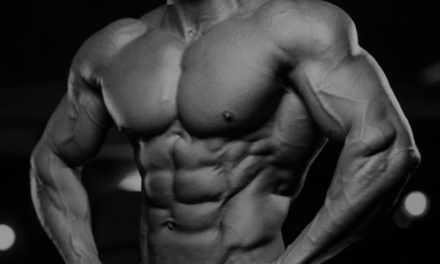Progressive Overload: The Key to Muscle Growth
Progressive overload is the most important principle of resistance training, for without it no progress would be possible. Our bodies are adaptive systems and will try to improve upon challenges by triggering an adaptation response.
This article requires your undivided attention because we are going to talk about the single most important variable when it comes to any training routine.
The Problem
I was around 17 years old when I went to my first gym session. I was shown all the machines and a workout plan was given to me from a female personal trainer. The idea was to do a certain amount of sets at a given weight, which she determined based on my current strength level.
The suggestion was to keep working with that plan for at least a month till we have a look at it again and change it to fit my progression. And here it goes, you get a personal trainer and the first thing they do is make sure you waste your first month in the gym, and then probably your second and third, and fourth, and…well, you get the point.
Related: Beginner’s Guide to Resistance Training
I do not understand why somebody would run in the gym several times a week and apply the same training routine every time without appropriate progression. This approach is called training for maintenance, and who wants to put in the effort over and over again without seeing any progress at all? We cannot even call this a plateau because plateau implies that you actively try to improve.
Not applying progressive overload in a workout routine is self-imposed and you simply reap what you sow. No surprises here.
I think the most relevant factor for results is mental, mainly in the form of motivation, commitment and focus. But once we forget motivational factors for progress in strength training or body development, we ultimately end up with one single idea—the principle of progressive overload. If every single time we visit the gym, we rigorously apply this concept to all our exercises, we would see guaranteed results.
Let’s get started.
Progressive Overload
The three major components of every resistance training program are specificity, overload, and progression.
- Specificity is derived from our goals and refers to the type of exercise we chose in order to drive adaptation responses within our body. If we want to increase our leg strength or size, we have to target the lower body.
- Overload simply means that we have to use a weight or otherwise change the exercise routine to challenge our body. This is extremely important. Without the stimulus of overload, even a well-designed exercise routine will not help us to achieve our goals. And the reason for this is that we will not be able to progress.
- Progression is the last variable and is as obvious as the last. We obviously have to progressively overload the muscle in every training session. If you stop to use heavier weights while maintaining all the other variables, you will stall and see no further progress. It can be very demanding to follow a strict program with an overload attempt during every session.
Specificity is important to know where we want to go, but ultimately only overload and progression are relevant variables for driving results.
Progressive Overload in Action
There are several ways to achieve progressive overload. It does not always need to be a heavier weight.
- Increase the Resistance: This one is probably the most obvious. If you want to be able to lift heavier weight, simply increase the weight (load) of the exercise over time. Only slight improvements are perfectly fine. Once your body has adapted to the new load, you can apply this logic again.
- Number of Repetitions: This might even occur naturally, especially if you are used to training until muscle fatigue. I always do my sets till fatigue and still see if I can bench press the same weight for an additional 1 or 2 times. A perfect sign of progress. But make sure you stay in either the strength (4-8) or hypertrophy (8-12) range. Once you reach 15+ repetitions, your muscle growth will be limited as you end up training too far in the muscular endurance range.
- Number of Sessions per Week: Simply go 4 instead of 2 times to the gym. Once you progress from a beginner stage to a more advanced stage in resistance training, you probably have to adjust your workout routine from a full-body workout to a split routine. This is usually done by increasing the number of gym sessions per week as well. You can also increase the training frequency in order to train lagging muscle groups. If the arms are your weak point, simply schedule an additional arm day during the week and see how it goes.
- Number of Sessions per Day: You can even go several times a day to the gym, but this is for more advanced athletes. You could go for a morning and an evening session, for example. Many advanced bodybuilders tend to eat and even nap at the gym for those reasons. This obviously depends on personal preference.
- Number of Sets per Exercise: Simply increase the sets of your workout routine from 3 to 5 or any other number you deem appropriate. This is the best method to increase volume (load*reps*sets), which is a very important variable for progress in strength training. Since you probably either train in the strength range or hypertrophy range, it is not really feasible to increase repetitions. Also, weight can only be increased slightly over time. It is very easy to add additional sets if you feel you have energy left or you just happened to have a great day and workout and want to give it your best.
- Number of different Exercises: You can also increase the number of exercises per Workout Session. Make sure to use a different kind of workout that trains the muscle group from a different angle and helps to shape it even better.
- Complexity of the Exercises: Change from machines to an Olympic Barbell. If you haven’t trained with free weights at all, this will work wonders. The logic here is similar to my usual advice to use mainly full-body compound exercises as the major components of your training. Not only are movements that load the spine better for stimulating the central nervous system to trigger a better hormone response (testosterone, human growth hormone, etc.), they also increase coordination, which is a different form of muscle engagement, and it also helps with bone development in order to prevent osteoporosis later in life.
- Length of rest periods between your sets: Another way to increase the overload is reducing the rest periods between your sets. This will increase the intensity of your workout. This is very useful to know since, if you are pressured for time, you can simply go all out and shorten your rest periods. This is also an awesome way to increase the pump we’ve all started to love. Supersets eliminate rest periods completely and are a very good way to save time and complete an awesome workout.
The idea of progressive overload is to shock the muscle and your body in a way that an adaptation response is triggered until the results specified have been achieved. All the changes above will help you to achieve that.
Recommendation: Focus on only one of those ideas at a time and see how it goes.
The further you climb the proficiency ladder, the more of those changes will be necessary to drive an adaptation response.
Related: How to Build Muscle: 5 Tips for Serious Mass
We can see our muscles getting stronger and increasingly fatigue-resistant over time. This is the major reasons why workout routines for beginners tend to be vastly different compared to routines for more advanced athletes.
At some point, you might be satisfied with your physique and want to change to a more relaxed training regimen. Once you have reached your goal, you can train for maintenance. But training for maintenance is more difficult than it looks. There is a phenomenon that once you stop getting better (and this applies to almost everything we do), you will stop being good at it. Progress is what gives us purpose and motivation to show up in the first place. If we are happy with the status quo, there is a high likelihood that we will drift slowly back to a stage we are no longer satisfied with. But this is just a sidenote.
Let’s take a look now at the natural progression in resistance training.
Beginner to Advanced: A Natural Progression
Another interesting fact is the change in your workout routine as you progress towards a more advanced level in strength training.
Beginner Workout
Beginner workouts tend to be full-body workouts with at least one day rest in between the different workout days.
Related: Beginner’s Guide to Resistance Training
This training program can be maintained for quite a while and probably longer than most people realize. The major reason why many people run into the gym for years without seeing any progress is that they keep using the same weights every time. Doing a full-body workout for three days a week is quite demanding. And if you stick to a reasonable progressive overload, you will gradually get stronger and your muscles will grow.
Fact: There is no need for supersets and drop sets or anything like that if you are a beginner.
Natural Progression
Once you have reached a certain level of conditioning, it makes sense to start with a split routine. The main reason is that your muscle groups will become better conditioned and hence fatigue-resistant. You will have to put more effort into training a particular muscle group to trigger further adaptations. Simultaneously, your recovery time will also increase. Due to the immense damage (higher volume per muscle group), the muscle needs more time to recover. You will also witness that beginner gains in strength training are awesome. They come easy and fast. So, enjoy your beginner gains as long as you can. It will not last.
Advanced Workout
The first step after the 3-day program is a natural progression to the push/pull/leg split. This is a nice split and simple to implement. If we go one step further and have a look at professional physique competitors, we see that most of them tend to train each muscle group only once per week, except for the arms, which are naturally involved in almost every exercise.
Related: How to Build Muscle: 5 Tips for Serious Mass
Wrap Up
The natural training progression over time is from a full-body workout 2-3 times a week until heavy isolated targeting of a single muscle group during one workout. This usually ends up in a complete split routine and 5-6 gym visits every week.
Here a short overview:
- Beginner Routine: 3 Days a Week + Full-body Program
- Intermediate Routine: 4-6 times a week: Some kind of push/pull/leg split
- Advanced: Anything you deem appropriate for further progress
Set Goals
If you have been reading carefully until now, you probably got this already.
There is a significant difference between working out and having an actual training goal during every workout session.
Progressive overload is a fundamental principle of resistance training. Without strength gain, there won’t be any significant muscle growth. And if you want to get stronger, it is essential to focus on lifting heavier weights over time. Many people train regularly with the same weights for years. Simply going to the gym and doing random exercises without a clear goal and progression has nothing to do with proper resistance training.
This basic fact gets more important the further you progress along the proficiency curve toward an advanced athlete. Progress is difficult; your body does not want to change further. Again and again, it simply wants to remain as it is.
Setting long-term goals and specific targets during every workout session will make sure you slowly progress toward that vision you have set for yourself.
Train; Do not work out!
I simply have to stress this basic fact all the time since this is the main reason why so much progress is left on the table. Simply working out a muscle or different muscle groups with as many exercises is not going to cut it if you do not specifically train for progress.
Focusing only on the standard exercises for each muscle group while applying progressive overload on a consistent basis will almost always do the trick. It is really simple. Just remember the following three points:
- Track Progress: Try to reduce the complexity of your training program and focus on the essentials, especially at the beginning. This will make it easier to track your progress.
- Increase Strength: Try to get consistently stronger with the foundation exercises. The actual resistance is the only relevant variable here as long as you can lift the weight 4-6 times.
- Increase Volume: If you are mainly training in the hypertrophy range, make sure to increase the volume all the time, whether this is due to heavier load, more sets during your workout, or more training sessions per week.
That’s it. It cannot get much simpler than that. Make sure that the weight you are lifting gets heavier over time. Not every time, but on a consistent basis. And it does not have to be much. This is another misconception. Increasing the weight too much will result in failure and hence demotivation, as your muscles do not have sufficient time to adjust to the new workload.
Progressive overload in its essence means only this: Train; do not work out!
Conclusion
I hope I was able to ingrain the concept of progressive overload in your brain and convince you that without it, there will be no progress and hence no results. Stagnation is the inevitable outcome of forgetting to properly challenge your muscles over time.
The comfort zone is the problem—the enemy, the epitome of low achievement and not getting anywhere. The human body will not change unless it’s forced to. And you have to force it time and again. Your body is the most stubborn team member you would have ever worked with.
It cannot be easier and more important to internalize this basic principle. If you keep lifting heavier over the course of time, you will see progress. It does not matter how bad your exercise program is structured as long as you keep progressing. The weight increase does not have to be much. Just slight progression overtime will accumulate to significant results over time. And as we have seen, there are several ways to get the results you want.
Do the following, but only one at a time. Increase the –
- Weight of the Exercise (Load)
- Sessions per Week (Simply go 4 instead of 2 times to the gym)
- Sessions per Day (this is for more advanced athletes)
- Sets per Exercise (from 3 to 5, for example)
- Number of different Exercises per Workout Session (5 instead of 3)
- Complexity of the Exercises (Change from Machines to an Olympic Barbell)
- Decrease the length of rest periods between your sets (supersets eliminate rest periods completely)
I value my time, and I am sure you do too. So, apply progressive overload during every training session. It will be exhausting, but without effort, there will not be any significant progress. Here at FitnessForTheWorld.com, we train to see improvements, fast and every week. Stagnation for long periods is not an option and does not align with our resistance training philosophy.
Recommended: V-Shape: Ultimate Guide to a Perfect Upper Body
If you found this post helpful, I’d love for you to kindly share it with your friends and followers on social media – just click any of the buttons below! Thank you











